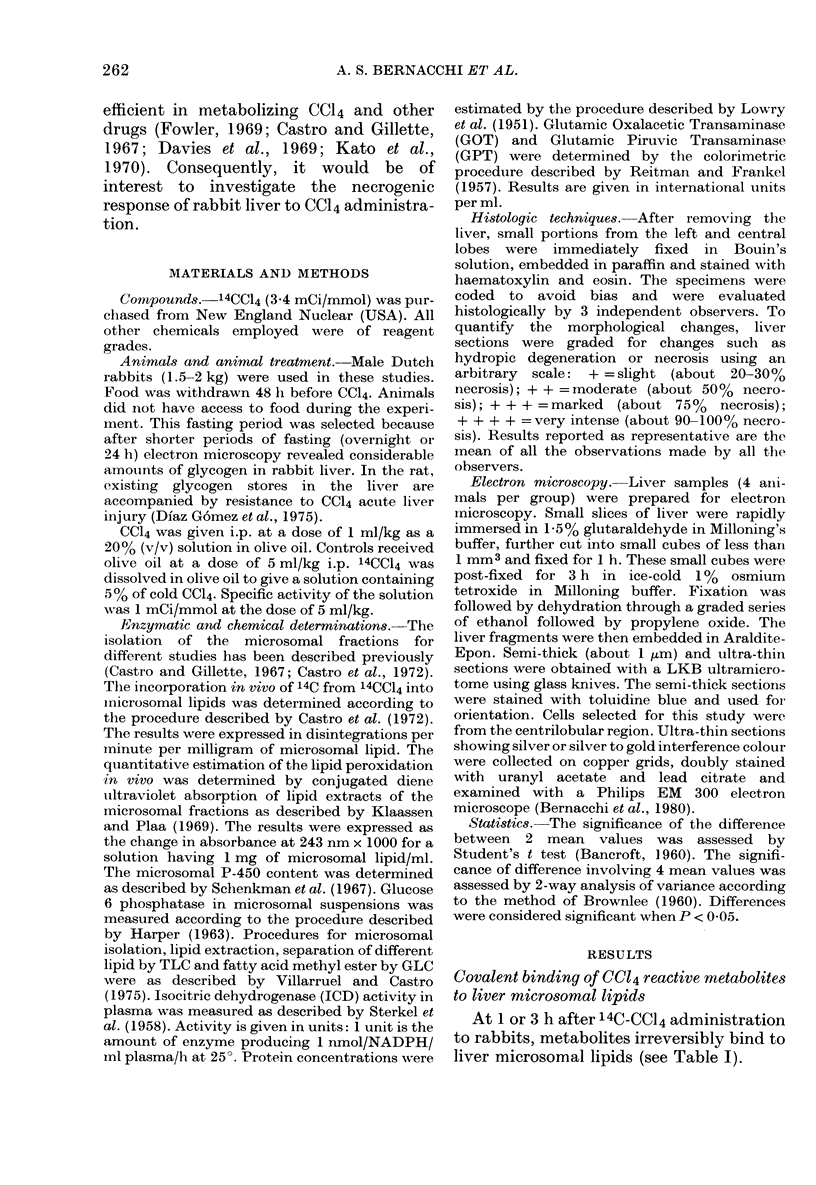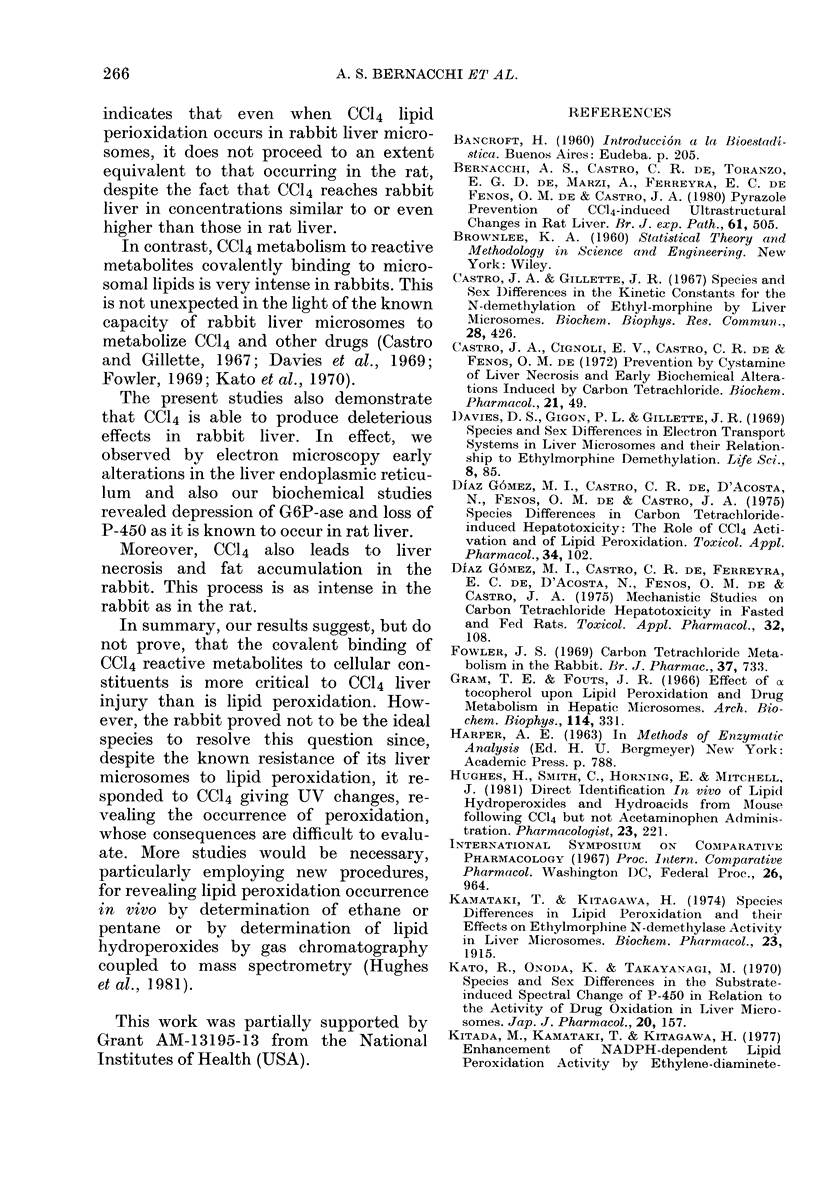Abstract
CCl4 administration to rabbits leads to early destruction of liver microsomal cytochrome P-450, to depression of glucose 6 phosphatase, to ultrastructurally revealable alterations and to an intense necrosis and fat accumulation in liver. Despite the known resistance of rabbit liver microsomes to lipid peroxidation, CCl4 administration to rabbits promoted lipid peroxidation of their liver microsomal lipids as revealable by the diene hyperconjugation technique, at periods of time from 1 to 12 h. Nevertheless, the intensity of this process is not equivalent to that occurring in rat liver microsomes, since the arachidonic acid content of rabbit liver microsomal lipids does not decrease at either 6 or 24 h after CCl4 administration. Rabbit liver is able to activate CCl4 to reactive metabolites that bind covalently to lipids. Relevance of covalent binding of CCl4 reactive metabolites and CCl4-promoted lipid peroxidation to CCl4-induced rabbit liver injury is analysed.
Full text
PDF






Images in this article
Selected References
These references are in PubMed. This may not be the complete list of references from this article.
- Bernacchi A. S., de Castro C. R., de Toranzo E. G., Marzi A., de Ferreyra E. C., de Fenos O. M., Castro J. A. Pyrazole prevention of CC14-induced ultrastructural changes in rat liver. Br J Exp Pathol. 1980 Oct;61(5):505–511. [PMC free article] [PubMed] [Google Scholar]
- Castro J. A., Cignoli E. V., De Castro C. R., De Fenos O. M. Prevention by cystamine of liver necrosis and early biochemical alterations induced by carbon tetrachloride. Biochem Pharmacol. 1972 Jan;21(1):49–57. doi: 10.1016/0006-2952(72)90249-3. [DOI] [PubMed] [Google Scholar]
- Castro J. A., Gillette J. R. Species and sex differences in the kinetic constants for the N-demethylation of ethyl-morphine by liver microsomes. Biochem Biophys Res Commun. 1967 Aug 7;28(3):426–430. doi: 10.1016/0006-291x(67)90329-4. [DOI] [PubMed] [Google Scholar]
- Díaz Gómez M. I., de Castro C. R., D'Acosta N., de Fenos O. M., de Ferreyra E. C., Castro J. A. Species differences in carbon tetrachloride-induced hepatotoxicity: the role of CCl4 activation and of lipid peroxidation. Toxicol Appl Pharmacol. 1975 Oct;34(1):102–114. doi: 10.1016/0041-008x(75)90179-9. [DOI] [PubMed] [Google Scholar]
- Fowler J. S. Carbon tetrachloride metabolism in the rabbit. Br J Pharmacol. 1969 Nov;37(3):733–737. doi: 10.1111/j.1476-5381.1969.tb08512.x. [DOI] [PMC free article] [PubMed] [Google Scholar]
- Kamataki T., Kitagawa H. Species differences in lipid peroxidation and their effects on ethylmorphine N-demethylase activity in liver microsomes. Biochem Pharmacol. 1974 Jul 1;23(13):1915–1918. doi: 10.1016/0006-2952(74)90203-2. [DOI] [PubMed] [Google Scholar]
- Kato R., Onoda K., Takayanagi M. Species and sex differences in the substrate-induced spectral change of P-450 in relation to the activity of drug oxidation in liver microsomes. Jpn J Pharmacol. 1970 Mar;20(1):157–163. doi: 10.1254/jjp.20.157. [DOI] [PubMed] [Google Scholar]
- Kitada M., Kamataki T., Kitagawa H. Enhancement of NADPH-dependent lipid peroxidation activity by ethylene-diamineteraacetic acid (EDTA) in the presence of ferrous ion in rabbit liver microsomes. Jpn J Pharmacol. 1977 Oct;27(5):653–657. doi: 10.1254/jjp.27.653. [DOI] [PubMed] [Google Scholar]
- Klaassen C. D., Plaa G. L. Comparison of the biochemical alterations elicited in livers from rats treated with carbon tetrachloride, chloroform, 1,1,2-trichloroethane and 1,1,1-trichloroethane. Biochem Pharmacol. 1969 Aug;18(8):2019–2027. doi: 10.1016/0006-2952(69)90299-8. [DOI] [PubMed] [Google Scholar]
- LOWRY O. H., ROSEBROUGH N. J., FARR A. L., RANDALL R. J. Protein measurement with the Folin phenol reagent. J Biol Chem. 1951 Nov;193(1):265–275. [PubMed] [Google Scholar]
- REITMAN S., FRANKEL S. A colorimetric method for the determination of serum glutamic oxalacetic and glutamic pyruvic transaminases. Am J Clin Pathol. 1957 Jul;28(1):56–63. doi: 10.1093/ajcp/28.1.56. [DOI] [PubMed] [Google Scholar]
- Rechnagel R. O., Glende E. A., Jr Carbon tetrachloride hepatotoxicity: an example of lethal cleavage. CRC Crit Rev Toxicol. 1973 Nov;2(3):263–297. doi: 10.3109/10408447309082019. [DOI] [PubMed] [Google Scholar]
- Recknagel R. O. Carbon tetrachloride hepatotoxicity. Pharmacol Rev. 1967 Jun;19(2):145–208. [PubMed] [Google Scholar]
- STERKEL R. L., SPENCER J. A., WOLFSON S. K., Jr, WILLIAMS-ASHMAN H. G. Serum isocitric dehydrogenase activity with particular reference to liver disease. J Lab Clin Med. 1958 Aug;52(2):176–184. [PubMed] [Google Scholar]
- Schenkman J. B., Remmer H., Estabrook R. W. Spectral studies of drug interaction with hepatic microsomal cytochrome. Mol Pharmacol. 1967 Mar;3(2):113–123. [PubMed] [Google Scholar]
- Slater T. F. Necrogenic action of carbon tetrachloride in the rat: a speculative mechanism based on activation. Nature. 1966 Jan 1;209(5018):36–40. doi: 10.1038/209036a0. [DOI] [PubMed] [Google Scholar]
- Villarruel M. C., Castro J. A. Irreversible binding of carbon tetrachloride to microsomal phospholipids. Free radical nature of the reactive specie and alterations in the physico-chemical properties of the target fatty acids. Res Commun Chem Pathol Pharmacol. 1975 Jan;10(1):105–116. [PubMed] [Google Scholar]
- del Villarruel M., de Toranzo E. G., Castro J. A. CC14 administration to strain A/J mice or rats and the arachidonic acid content of their liver microsomal prospholipids. Res Commun Chem Pathol Pharmacol. 1976 May;14(1):193–196. [PubMed] [Google Scholar]




